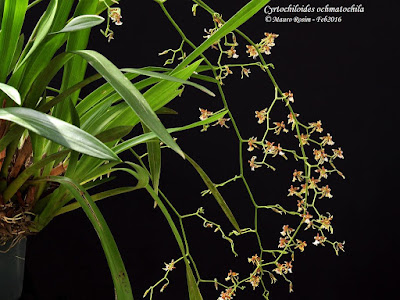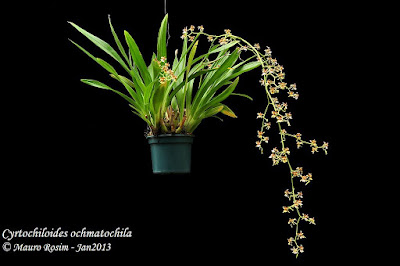Cyrtochiloides ochmatochila - Bridle-Like Lip Cyrtochiloides flowers are 3 cm in diameter, lilac scented. Sepals, petals are green-yellowish to white
Cyrtochiloides ochmatochila, also called as Bridle-Like Lip Cyrtochiloides, Cyrtochiloides cardiochila, Odontoglossum cardiochilum, Oncidium cardiochilum, Oncidium chelidon, Oncidium chelidonizon, Oncidium ochmatochilum, is a species in the genus Cyrtochiloides. This species was described by Norris H. Williams and Mark Wayne Chase in 2001.
DESCRIPTION OF CYRTOCHILOIDES OCHMATOCHILA - BRIDLE-LIKE LIP CYRTOCHILOIDES
Cyrtochiloides ochmatochila is native to Southeastern Mexico to Peru. It is found growing on shade trees in coffee plantations in Colombia, Costa Rica, Ecuador, Guatemala, Honduras, Mexico Southeast, Panamá, Peru at elevations of 700-1400 meters above sea level.
It is a large sized, warm to cool growing epiphyte with pyriform, ovoid, up to 13 cm long pseudobulbs that are enveloped basally by large, imbricating leaf sheaths. The leaves are 2, apical, erect, oblanceolate, oblong, acute, up to 65 cm long.
Bridle-Like Lip Cyrtochiloides blooms in the fall from the axillary, 210 cm long, 15-25 branched (5 to 8 flowered branch), racemose, paniculate inflorescence that arising on a mature pseudobulb. The flowers are 3 cm in diameter, lilac scented. Sepals and petals are green-yellowish to white, with brown-reddish patches; lip with white intermediate lobe, lateral lobes and isthmus are brown-orange, white edges, column with orange upper half and callus with orange patches.
CYRTOCHILOIDES OCHMATOCHILA - BRIDLE-LIKE LIP CYRTOCHILOIDES CARE
Cultural information should only be used as a guide, and should be to be adapted to suit you. Your physical location; where you grow your plants, how much time you have to devote to their care, and many other factors, will need to be taken into account. Only then can you decide on the cultural methods that best suit you and your plants.
Light:
Cyrtochiloides ochmatochila needs a light level of 15000-25000 lux for mature plants, but less for young plants and when temperatures are high (70% shade cloth over summer and more light in winter). The leaves should be a medium green to slightly yellow- or red-tinged, never dark, glossy green. Leaves turn reddish blue if receiving too much light and leaf loss will occur if too sun damaged. Dark green leaves indicate insufficient light. A slight bronzing of the leaves and older bulbs indicates the light is good for flowering. Strong air movement should be provided all the time.
Temperature:
The average temperature on the summer day is 24-27 ° C, and on the summer night it is 16-18 ° C, which gives a daily difference of 9-11 ° C. The average temperature on the winter day is 20-24 ° C and at night 10-13 ° C, giving a daily difference of 8-10 ° C.
Humidity:
Bridle-Like Lip Cyrtochiloides prefers a humid environment, preferably between 40 and 80% humidity (ideal 65%). It is important to damp down the greenhouse floor or use misters to increase humidity in hot weather. Protect against hot dry wind. Pots can be placed on gravel filled trays containing water in summer to increase humidity but pots must not sit in water. Accordion pleating of leaves can be a symptom of insufficient water or humidity or irregular watering. However the pleating can also be genetic in some cases and unavoidable.
They need good air movement, particularly as humidity increases, and fans are advisable to prevent fungal diseases. Leaf fungal diseases and black spotting can be a problem for the plant.
Substrate, growing media and repotting:
Cyrtochiloides ochmatochila are usually grow in pots filled with a loose, permeable substrate that allows the roots to dry quickly after watering. They should be grown in small bark (5-10mm) perlite potting mix (5:1) or in sphagnum moss and perlite (70:30). Some growers place a layer of sphagnum moss on the top of the pot to reduce evaporation and keep the roots cool. They can also be grown in perlite with a layer of gravel on the top. They should be grown in small squat pots that allow more frequent watering. The base of the new growth should be planted about 1.5cm into the bark but no deeper. Keep bark barely moist until new roots appear then resume normal watering.
Since the roots of these plants do not tolerate decaying substrate, they should be repotted every year to every 2 years before the substrate starts to decompose. This is best done when new roots are beginning to grow. This allows the plants to acclimate in a relatively short time and provides them with the least stress.
Watering:
Bridle-Like Lip Cyrtochiloides like abundant water and require frequent watering in warmer months. When the new growths reach maturity in the fall, the amount of water should be reduced. They must never be allowed to dry out. Try to water in the mornings and not in the heat of the day or late afternoon as leaves may stay wet during the evening.
They are very sensitive to poor water quality which will inhibit root growth and cause leaf-tip burn. Pots should just begin to dry before watering. Misting daily in very hot weather is recommended. To reduce leaf spotting, avoid watering in the heat of the day or late afternoon in warmer months. Also avoid wetting the leaves and water the pot, not the leaves.
Fertilizer:
Cyrtochiloides ochmatochila require frequent application of 20-20-20 fertilizer diluted to one-quarter to onehalf of the recommended strength all year round but less in winter. Apply fertilizer every 2 weeks when growing actively but monthly when less active. Periodically, collect rain water and use it to rinse fertilizer salts that accumulate in the mix. They are not gross feeders and too much fertilizer will harm their roots and turn leaf tips brown. Use of high phosphorus or potassium fertilizers as plants approach flowering can increase flower count and substance.
Rest period:
Bridle-Like Lip Cyrtochiloides need less water in the winter, especially if they grow under the conditions of a dark, short day that occurs in moderate latitudes. Occasional morning misting between occasional light waterings will generally provide sufficient moisture for the plants during a cool, dry winter period. However, the amount of water can be increased if the pseudobulbs start to wrinkle and the leaves hang down. You can let the plants dry between the next watering, but you must not let the plants stay dry for a long time. Fertilization should be limited or should be completely abandoned until spring, when stronger watering resumes.















COMMENTS